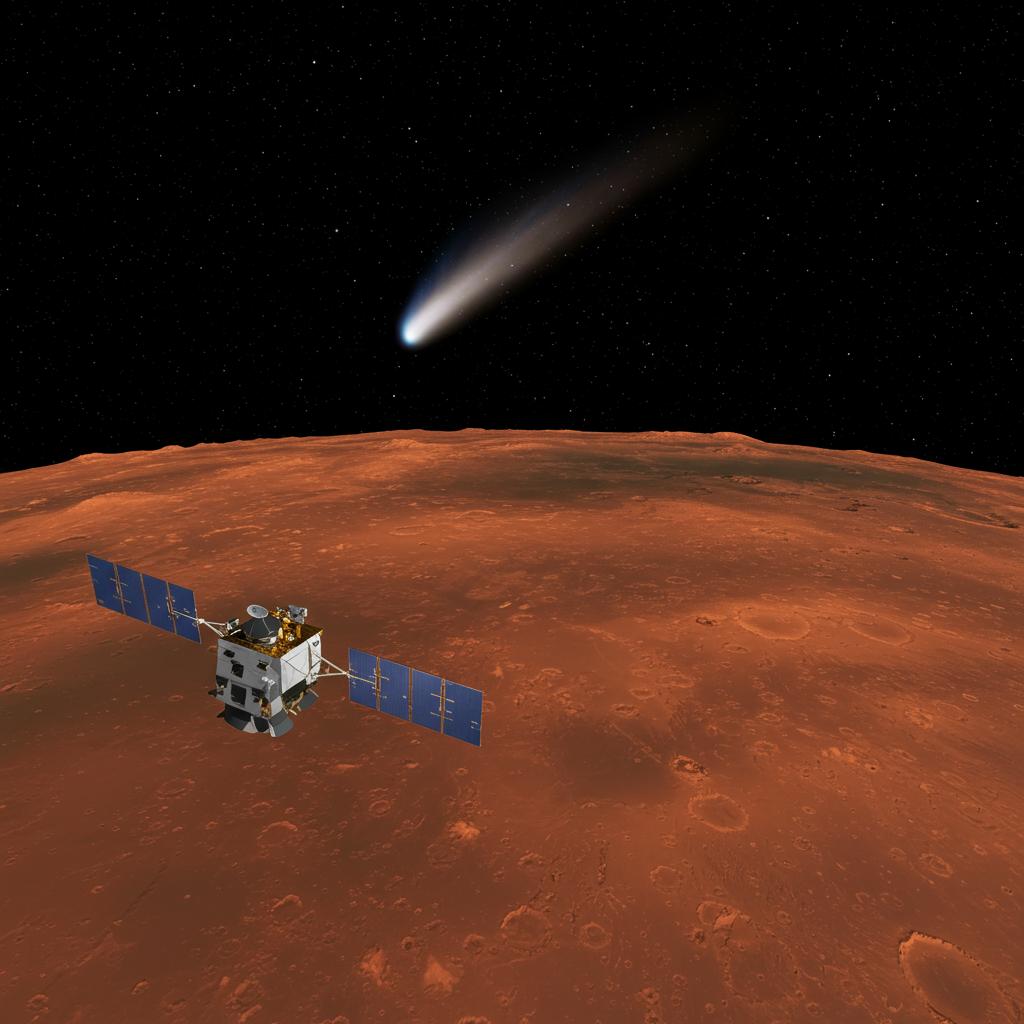The cosmos continually astounds us with its mysteries, and few events spark more wonder than a visitor from beyond our solar system. Recently, a fleeting encounter between Mars and a rare interstellar comet, designated 3I/ATLAS, captivated scientists and space enthusiasts alike. Captured in groundbreaking images by European Space Agency (ESA) orbiters, this marks only the third confirmed instance of an interstellar object traversing our cosmic neighborhood. These unprecedented observations offer a unique window into the universe’s farthest reaches, providing invaluable clues about the formation of distant worlds.
A True Outsider: Unveiling Interstellar Comet 3I/ATLAS
First detected on July 1, 2025, by the NASA-funded ATLAS (Asteroid Terrestrial-impact Last Alert System) telescope in Chile, comet 3I/ATLAS quickly distinguished itself. Its hyperbolic orbital path confirms an origin far beyond our sun’s gravitational pull, unequivocally identifying it as an interstellar object. This “true outsider” drifted through interstellar space for millions, perhaps even billions, of years before entering our solar system from the general direction of the constellation Sagittarius.
The scientific community recognizes 3I/ATLAS as a monumental discovery. Before its arrival, only two other interstellar objects had ever been confirmed: 1I/’Oumuamua in 2017 and 2I/Borisov in 2019. Its designation, 3I/ATLAS, adheres to standard astronomical naming conventions, honoring its discovery team and marking its status as the third such visitor.
Tracing its Ancient Origins
Astronomers believe 3I/ATLAS could be the oldest comet ever observed, potentially predating our solar system’s birth by approximately three billion years. This ancient genesis suggests an exotic journey, carrying primordial material from an entirely different star system. When first discovered, it was roughly 410 million miles (670 million kilometers) from the Sun, within Jupiter’s orbit. Traveling at about 137,000 miles per hour (221,000 kilometers per hour), its speed continues to increase as it draws closer to our star.
Unprecedented Views: Mars Orbiters Capture a Cosmic Wanderer
The pinnacle of 3I/ATLAS’s journey through our inner solar system came in early October 2025. Between October 1 and 7, it made a close flyby of Mars, offering an extraordinary opportunity for close-range observation. The European Space Agency’s ExoMars Trace Gas Orbiter (TGO) and Mars Express spacecraft both turned their instruments toward the inbound comet. On October 3, 3I/ATLAS passed within approximately 18.6 million miles (30 million kilometers) of Mars and the orbiting spacecraft.
Images taken by TGO’s Colour and Stereo Surface Imaging System (CaSSIS) on October 3 depict the comet as a bright, fuzzy white dot. This “fuzzy blob” appearance represents its icy-rocky nucleus, estimated to be between 1,444 feet (440 meters) and 3.5 miles (5.6 kilometers) in diameter, enveloped by a vast coma – a cloud of gas and dust spanning a few thousand kilometers. Notably, initial observations did not resolve a distinct tail, though scientists anticipate its formation as the comet approaches the Sun.
The Challenge of Faint Light: Engineering a Cosmic Snapshot
Capturing these images proved to be an immense technical challenge. Nick Thomas, principal investigator for the CaSSIS camera, highlighted the difficulty, stating, “The comet is around 10,000 to 100,000 times fainter than our usual target.” TGO’s imaging system, primarily designed for photographing Mars’ surface, had to adapt significantly. To overcome the extreme faintness and reveal the elusive object, scientists meticulously stacked multiple five-second exposures.
The Mars Express orbiter also attempted to photograph 3I/ATLAS. However, its imaging systems, with a maximum exposure time of just 0.5 seconds, faced even greater difficulties. This limitation made resolving the faint comet in its imagery particularly arduous. Colin Wilson, ESA project scientist, expressed enthusiasm for the mission’s flexibility, underscoring the excitement of observing such unexpected celestial events.
Journey Through Our Solar System: 3I/ATLAS’s Path and Future Visibility
The interstellar comet 3I/ATLAS is currently on a temporary visit, tracing a path that will eventually lead it out of our solar system. Its closest approach to the Sun is anticipated around October 30, 2025, at about 1.4 astronomical units (130 million miles or 210 million kilometers), positioning it just inside Mars’ orbit. While it will pass between the orbits of Mars and Earth, NASA has unequivocally stated that the comet poses no threat to our planet, maintaining a safe distance of approximately 1.8 AU (170 million miles or 270 million kilometers) during its closest flyby.
Initially visible to ground-based telescopes earlier in the year, 3I/ATLAS is expected to remain observable through September before moving too close to the Sun for direct viewing. It will then reappear on the opposite side of the Sun in early December. After its perihelion (closest point to the Sun), the comet will continue its journey past Jupiter in March 2026 before venturing out of our solar system, never to return.
Why 3I/ATLAS Matters: Unlocking Universal Secrets
The profound scientific interest in interstellar comet 3I/ATLAS stems from its unique origin. Unlike all other celestial bodies within our solar system, which share a common evolutionary history, 3I/ATLAS carries pristine material from an entirely different stellar neighborhood. This makes it an invaluable cosmic messenger, potentially holding “clues about the formation of worlds far beyond our own,” as highlighted by ESA officials.
Studying 3I/ATLAS allows astronomers to analyze its composition and physical properties. This data can offer unprecedented insights into exoplanetary formation processes and the raw materials available in other star systems. Scientists are analyzing spectral measurements, attempted by instruments like Mars Express’s OMEGA and SPICAM and ExoMars TGO’s NOMAD spectrometers, to understand the comet’s coma and potential tail. Its extreme age further amplifies its scientific value, offering a glimpse into conditions present billions of years ago.
The Future of Observation: What’s Next for This Cosmic Wanderer?
The close-up observations from Mars orbiters are just one piece of a much larger, coordinated scientific effort. Numerous space-based and ground-based assets are tracking interstellar comet 3I/ATLAS. NASA’s Hubble Space Telescope captured images in July, revealing a teardrop-shaped cocoon of dust, and continues its observations to refine nucleus size estimates. The James Webb Space Telescope (JWST) used its Near-Infrared Spectrograph in August, with data currently undergoing analysis.
Further observations are planned by a suite of advanced instruments including the SPHEREx space observatory, TESS, Swift, the Parker Solar Probe, PUNCH, and even the Perseverance and Curiosity Mars rovers, Mars Reconnaissance Orbiter, Europa Clipper, Lucy, Psyche, and ESA/NASA’s SOHO and Juice missions. Notably, ESA’s Jupiter Icy Moons Explorer (JUICE), currently en route to Jupiter, is scheduled to begin its search for 3I/ATLAS in November 2025, just after the comet’s closest approach to the Sun. Scientists anticipate the comet will be in a more active state post-perihelion, enhancing JUICE’s chances of successful observation. Looking further ahead, ESA is developing the Comet Interceptor mission, slated for launch in 2029, specifically designed to rendezvous with pristine comets or future interstellar objects like 3I/ATLAS.
Frequently Asked Questions
What is 3I/ATLAS and why is it considered so rare?
3I/ATLAS is an interstellar comet, meaning it originated from beyond our solar system. It is only the third such object ever confirmed to have entered our cosmic neighborhood, making it exceptionally rare. Its hyperbolic orbit, which is unbound by the Sun’s gravity, confirms its origin from another star system. Scientists believe it may be the oldest comet ever observed, potentially billions of years older than our solar system itself, carrying unique material from distant stellar environments.
Which space agencies and telescopes are observing 3I/ATLAS?
Numerous international space agencies and telescopes are observing interstellar comet 3I/ATLAS. The European Space Agency (ESA) captured groundbreaking images using its ExoMars Trace Gas Orbiter (TGO) and Mars Express spacecraft during the comet’s flyby of Mars. NASA, in coordination with ESA, is utilizing the Hubble Space Telescope, James Webb Space Telescope (JWST), SPHEREx, TESS, Swift, Parker Solar Probe, and PUNCH. Even Mars rovers like Perseverance and Curiosity, along with the Europa Clipper, Lucy, Psyche, and JUICE missions, are contributing to this comprehensive observation campaign.
How will studying 3I/ATLAS benefit our understanding of the universe?
Studying interstellar comet 3I/ATLAS offers an unparalleled opportunity to understand the broader universe. As a “true outsider” from another star system, it carries unique compositional clues about planetary formation processes beyond our own solar system. By analyzing its icy-rocky nucleus and coma, scientists can gain insights into the raw materials present in distant stellar nurseries. Its extreme age further provides a window into ancient conditions, helping astronomers piece together the complex history and evolution of matter across the galaxy.
A Celestial Legacy: Insights from an Interstellar Wanderer
The visit of interstellar comet 3I/ATLAS represents a triumph of astronomical observation and scientific collaboration. Its close approach to Mars provided unprecedented imagery, overcoming immense technical challenges. As scientists continue to pore over the vast amounts of data collected by a global network of telescopes and spacecraft, the secrets held within this ancient cosmic wanderer are gradually being unveiled. Each new insight from 3I/ATLAS brings us closer to understanding not only the origins of our own solar system but also the diverse and complex processes that shape worlds across the vast expanse of the universe. The legacy of this rare visitor will undoubtedly inspire future missions and deepen our appreciation for the dynamic cosmos we inhabit.



